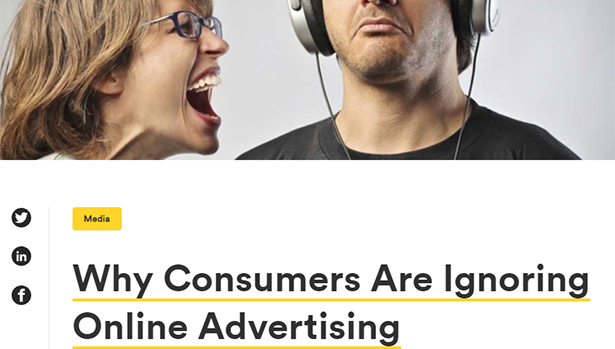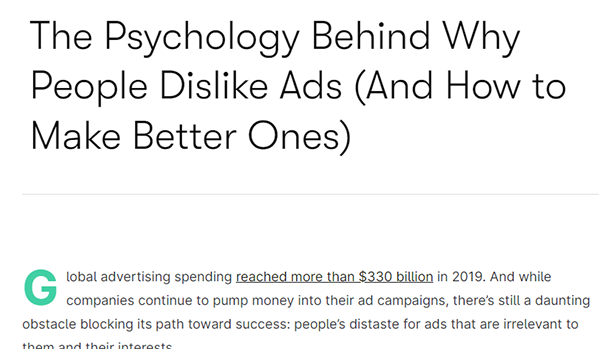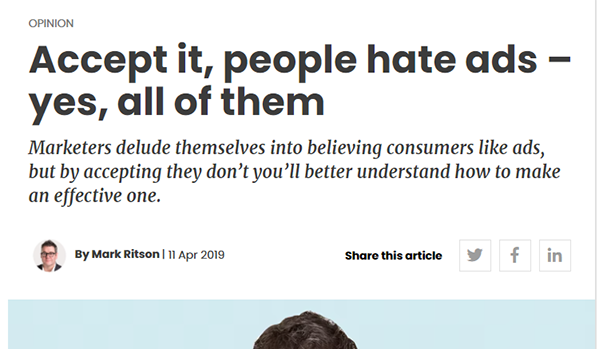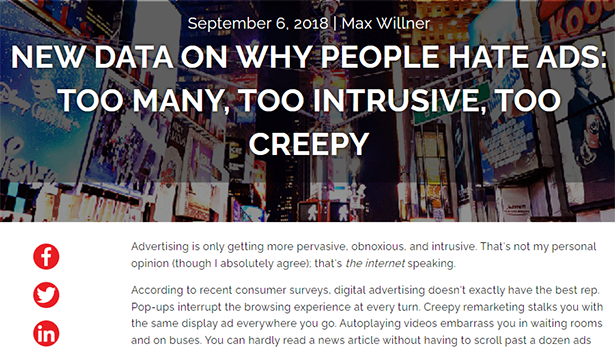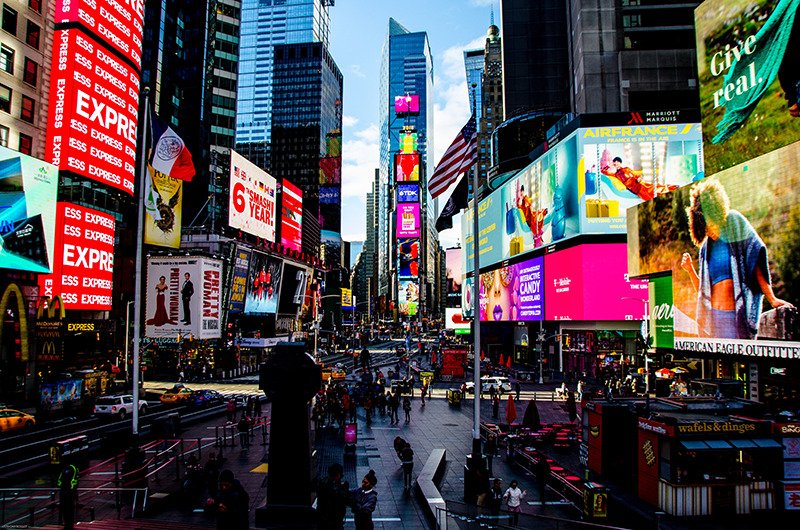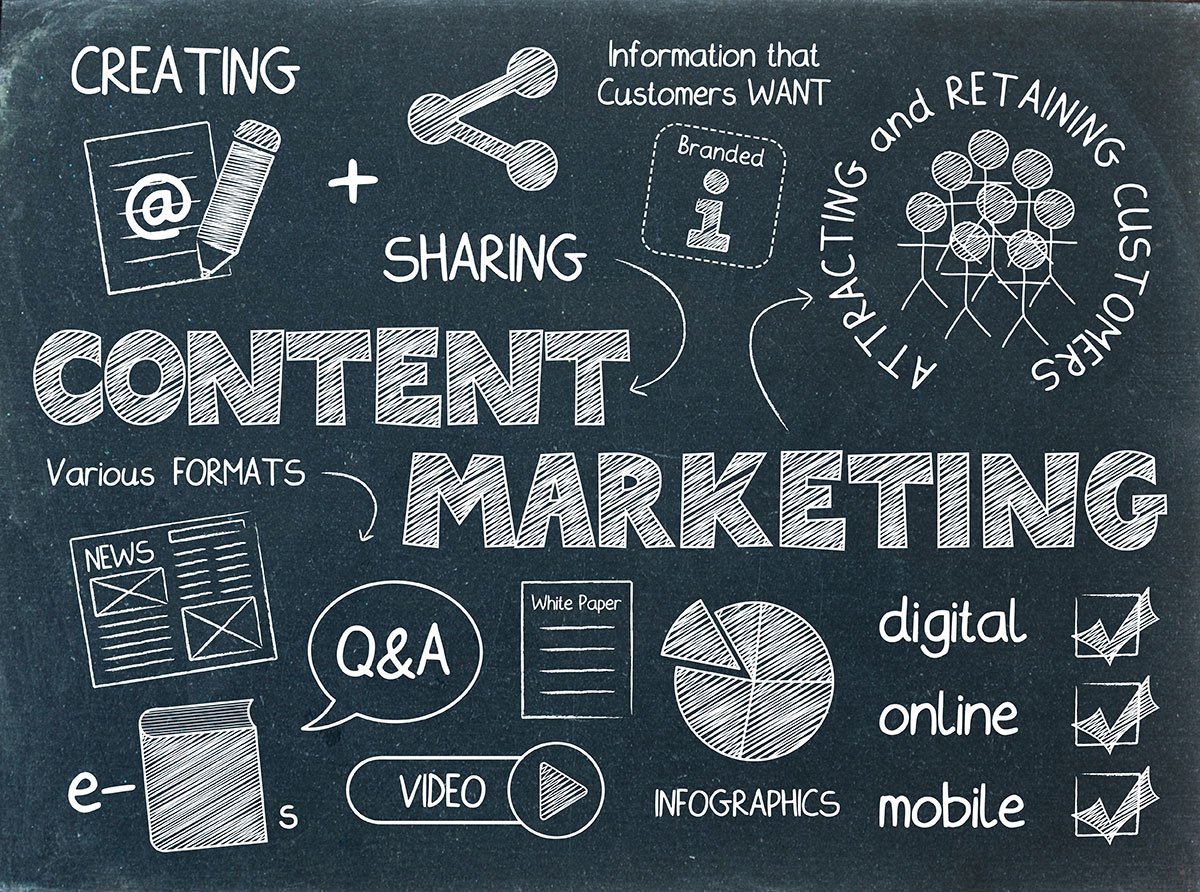As Paid Advertising Dies It Will Go *Crazy*
As we discussed in a recent last blog post, paid ads both work and don’t work. They’re better than nothing, but not much. And they’re inferior to many alternatives. We’re in the midst of a paradigm shift (from seller-centric thinking to buyer-centric thinking), prompted by the buyer-driven Buyer Journey; and paradigm shifts are marked by crazy attempts to revive the failing modality, understanding, or practices.

Statistics showing that marketing is undergoing an evolution in thinking from being seller-centric, to being buyer-centric, are undeniable.
Some call it banner blindness. Paid advertising is yielding less, as a function of cost, despite greater and greater targeting and presentational technologies and innovations powering it.
At this point, what would have become unconscionable in 2005 is commonplace today, including:
- Remarketing.
- Smart phones that listen to your private conversations.
- Cameras on devices that can read where your eyes are on a page, or the extent of dilation of your pupils.
- Smart phones that can geolocate you down to 3′, detect your body temperature, activity, motion and velocity, and respiratory rate – when you look at ads, or when you are just living.
- Smart Phones that, by default, feature audible notifications for as humdrum an event as an email from a vendor, which might be a newsletter or sales notification.
- AI that has a behaviorally-predictive calendar of your routines.
- Customized eCommerce websites with data analysis that compares your profile and the variables determining your purchases, and which can predict what you will buy.
- In-game and in-app advertisements.
- Unsolicited emails from LinkedIn, WinRed, ActBlue, Fiverr users, who were sold your contact information.
- Unsolicited emails scraped from Seamless.io, Apollo, and other ‘lead generation’ platforms.
- Cross-app and cross-platform tracking and targeting that really amounts to a violation of privacy.
- Music platforms as well as video platforms have increased the volume of ads shown. They are especially interruptive, because unlike display ads, they can’t be ignored or closed-down.
‘Interruption marketing’ – the 1950’s Ogilvy, ‘Mad Men’ model – has become weaponized by technology, wielded by rookie marketers who don’t realize Web 2.0 changed everything, and people now look for content and come to vendors, and don’t want to be interrupted during this process. The data show it. Experts are saying it, and have been for a decade. Our own buying habits reveal it: you, yourself (as a marketer or consumer) are shown and ignore roughly 10,000 ads every day.
We believe there’s a place for paid placements (offering objective-value, seller-centric, content), and there always will be. But the days of SEM and GDN offering significant returns, especially without or at the expense of content offers, are nearing an end.
Google, once considered the gold standard in fair-minded and sustainable practices, is now spamming YouTube with pre-roll, and in-video ads. Programmatic marketing platforms, the competition for Google Display Network (GDN), have slowed Google’s rising PPC costs, but not much, and are witnessing the same falling click-through rates. They are all charging more, to more competitors, for lower yield.
- Advertising is becoming more intrusive to consumers, who are increasingly reaching for ad-blocking solutions.
- Advertising is offering lower ROI to vendors.
- And lastly, ad displaying or hosting websites aren’t getting near the revenue money they were even 5 years ago, measured any way.
Volume (and market gains from programmatic networks) in theory present a downward force on rising advertising costs, but with the yield collapse outpacing those falling prices, paid advertising presents a growing loss for vendors. It’s like getting a raise that doesn’t keep up with inflation.
Dying paradigms, whether it’s the United States spraying exfoliating herbicides on jungle trees at the end of Vietnam, or Kamikaze fighters flying into warships in the final days of WWII, are always marked by a whole lot of crazy, as invested parties continue to beat dead horses and cannot accept that the old ways are not working, or the dream is dead. ~ FlashPointLabs
If you look at the evolution of anything – technology, history, and culture – you see some patterns:
- At the point that change (evolution or a paradigm shift) is necessary, or revolution is called-for and detectable, the underlying problems had existed for a considerable length of time;
- There are many market players and forces invested in the ‘old way’;
- Innovative and eventually, grotesque, attempts to keep the ‘old way’ alive will be witnessed.
The end of any paradigm, whether it’s the fall of the Berlin Wall, or Rome; whether it’s withdrawing in Vietnam, or moving from analog to digital computers – is marked by grotesque and unnatural iterations of the old thinking and technology. A failure to understand times had changed. The de facto death of widespread paid digital marketing will be no different.
We’ve never had better data about consumers – individually and in the aggregate; never been better able to test ads; never been better able to optimize ad spend; never been better able to see what’s working and what’s not; never been better able to target ads at people like to buy. We’re using AI to do this now. We’re leveraging more and more power and intelligence at restoring falling click-through rates; and we’re failing. Because we’re (most of us) do not comprehend the root problem.
It’s now self-evident that a buyer-driven Buyer Journey necessitates helpful, objective-value, buyer-centric, content.
Diminishing click-through rates are a byproduct of a) more ads being shown, and b) people getting sick of ‘interruption marketing’; companies that market without consent are keeping Google and Facebook afloat, while driving a trickle of leads, and leveraging more and more sophisticated technology to solve a problem fundamentally rooted in psychology: you have to give to receive. You have to help people with buyer-centric content, not sell them with seller-centric content.
Things are quickly reaching a kind of marketing singularity, where technology is reaching a ceiling.
We are in the midst of a paradigm shift in marketing and advertising; witnessing the effective death of paid advertising. The situation is impossible to ignore or deny: paid digital ads are increasingly cost-ineffective.
This trend of ‘more tech, diminishing yields’ in paid advertising will reach still more absurd levels before it finally dies. We will continue to exploit technology to stalk, profile, pester, hound, and target consumers, in increasingly creepy, disruptive, and unethical ways, effectively weaponizing ‘interruptive marketing’ for diminishing wins, before the practice is abandoned altogether.
What Do We Make Of This? What Other Options Do We Have?
Since click-through rates for paid ads were never very high to begin with (about 5% at the birth of the Internet), it’s not entirely the case that Web 2.0 killed paid advertising.
It basically never really worked, next to organic. The best news in all this is that we have ‘the automobile’ to replace the horse and buggy. We have better ways to do things. It’s called content marketing; it’s employing an approach that helps, rather than sells, leads; it’s creating and sharing objective-value content and giving it away for free, to pull leads, rather than pushing ads before consumers.

